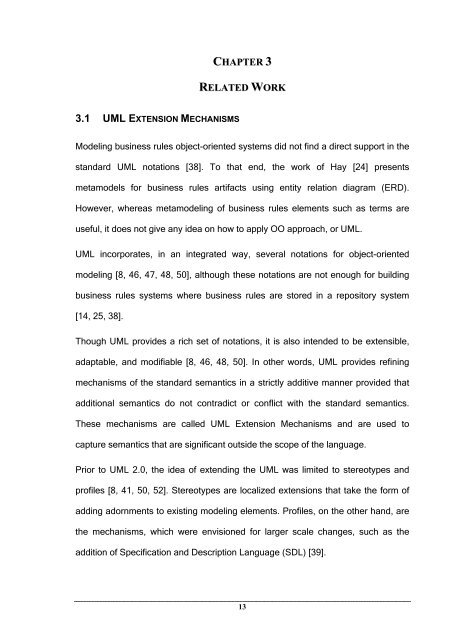TADESSE TAREKE.pdf - Addis Ababa University
TADESSE TAREKE.pdf - Addis Ababa University
TADESSE TAREKE.pdf - Addis Ababa University
Create successful ePaper yourself
Turn your PDF publications into a flip-book with our unique Google optimized e-Paper software.
3.1 UML EXTENSION MECHANISMS<br />
CHAPTER 3<br />
RELATED WORK<br />
Modeling business rules object-oriented systems did not find a direct support in the<br />
standard UML notations [38]. To that end, the work of Hay [24] presents<br />
metamodels for business rules artifacts using entity relation diagram (ERD).<br />
However, whereas metamodeling of business rules elements such as terms are<br />
useful, it does not give any idea on how to apply OO approach, or UML.<br />
UML incorporates, in an integrated way, several notations for object-oriented<br />
modeling [8, 46, 47, 48, 50], although these notations are not enough for building<br />
business rules systems where business rules are stored in a repository system<br />
[14, 25, 38].<br />
Though UML provides a rich set of notations, it is also intended to be extensible,<br />
adaptable, and modifiable [8, 46, 48, 50]. In other words, UML provides refining<br />
mechanisms of the standard semantics in a strictly additive manner provided that<br />
additional semantics do not contradict or conflict with the standard semantics.<br />
These mechanisms are called UML Extension Mechanisms and are used to<br />
capture semantics that are significant outside the scope of the language.<br />
Prior to UML 2.0, the idea of extending the UML was limited to stereotypes and<br />
profiles [8, 41, 50, 52]. Stereotypes are localized extensions that take the form of<br />
adding adornments to existing modeling elements. Profiles, on the other hand, are<br />
the mechanisms, which were envisioned for larger scale changes, such as the<br />
addition of Specification and Description Language (SDL) [39].<br />
13

















